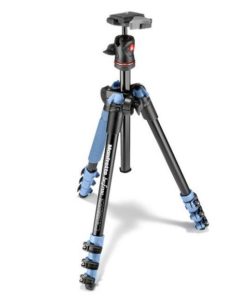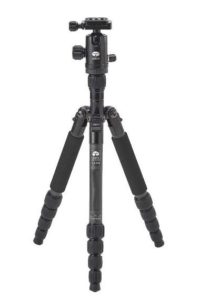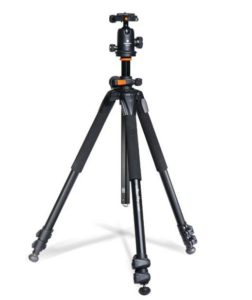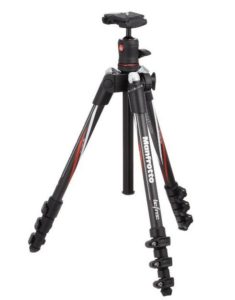
Nothing makes a photograph look worse than an unsteady hand. And here’s the thing about hands – their all unsteady. To alleviate this problem both amateur and professional photographers use tripods. It’s easy enough the use a tripod when you’ve got your own studio . . . the disadvantages to this are, obviously, that not everyone has their own studio and hard to get shots (like wildlife and athletic events) are hard to capture, much less do they come into a studio and pose for a shot. In order to help fix this, a number of online sellers offer the best travel tripods on the market. There isn’t one model of tripod that necessarily better than all the rest. Like any tool, travel tripods have a number of features that make them the best for a specific situation. This article will take a look at a few of the uses and features of some of the best DSLR tripods and describe what makes those features indispensable for anyone who wants to capture great photos using the best tripod for DSLR video or camera.
A Little History
Tripod means, in Greek, three footed. When most people think of a tripod they probably think of three legs or stands but the idea is still the same. Perhaps people also think of the tripods of photography’s antiquity. When a bearded man would have a tall, wooden tripod with a monstrous camera perched on top and a cloth to cover his head for the solar like flash that was about to go off. Tripods were essential in early photography because of the long exposure times necessary to get a good picture. That’s why people didn’t smile in early photos – it wasn’t the cholera, tuberculosis, and bad dental care – people just couldn’t hold a smile for that long. Not much has changed when it comes to long exposure time. If a long exposure going to look right, a photographer still needs to use a good tripod. Actually, tripods go back further than daguerreotypes. Painters used them in abundance to hold their canvasses still, and even then there were tripods made that were specifically meant to be used a traveling tripods. They were smaller, lighter, and easier to adjust and set up. Think of Can Gough standing in a field of tulips, using his thumb to gauge the light.
What’s in It?
It’s worth mention here that most tripods are now made of aluminum or carbon fiber and choosing the right material is necessary to get the desired shots. Generally speaking, those looking for a travelling tripod will go with carbon fiber. Most of the best travelling tripods are made from carbon fiber and though they are the most expensive, their worth it. Carbon fiber is used by the government on various civil engineering projects and is 10 times stronger than steel. It is a grouping a long, crystalline strands that are woven into a grid to create an incredibly strong material.
ISO Info
In terms of taking pictures, the lower the ISO the better. A good tripod can bring your ISO down to 200 and can ensure there’s less noise in the picture and that the light going into your lens is not clouded by changing positions. Good DSLR cameras already have pretty low ISO rating, so if enough money is spent on a camera the need for a tripod is lessened. But, getting the best tripod for DSLR video or camera that’s already state-of-the-art will only enhance any photos it captures. Another feature of DSLR cameras is the ability to leave the lens opened for virtually as long as the environment will allow. This makes it ideal for capturing the nighttime sky and taking photos of star trails and the movement of the moon. This is an area where a travel tripod is absolutely necessary. It’s hard for a person to stand in one place long enough to get good star trails, much less keep the camera steady. So the first two, and probably most important, reasons to use a tripod are a low ISO rating and stillness / long exposure shots.
Also, remember that most DSLR cameras take videos, and having a stable base for video is extremely important. A basic rule of thumb, “The best tripods for DSLR cameras are the best tripods for DSLR video.” The only caveat being that a handle is really helpful in order to freely turn the camera to capture video. It’s important to make sure that a tripod has amount for a handle if it’s going to be one of the best tripods for DSLR video.
The Game is Afoot
Let’s start at the bottom and talk about feet. Just like for people, tripods need shoes. Well, they need different types of feet for different occasions. Higher-end tripods come with different kinds of feet and they can be swapped out for different occasions. You might want to use feet with little spikes in them if you’re shooting in a muddy field and there’s a wind, or if you’re in icy conditions then treaded rubber feet are appropriate. A tripod either begins or ends with its feet, depending on a person’s position. Either way, it’s an important position to be in.
Attached to the feet are the legs. There are really only two types of tripod legs – tubular and non-tubular. This author doesn’t think there’s much a difference between the two, other than their shape. It should be kept in mind that thicker isn’t always better. Remember, part of what makes a tripod one of the best travel tripods is its weight. Having to carry a heavy tripod a great distance can be daunting and cumbersome if some of that distance means crawling through tight spots. The legs have the potential to weight a great deal and thinner legs mean a lighter tripod. The problem with lighter legs is that they are more likely to be blown or knocked over. Consider what and where the tripod will be used.
The Head and Body
Not all tripods come with this next item – a center post. If the body analogy is being continued then the center post acts as the body of the tripod. The problem with the center post is that it isn’t really necessary. Sure, it can help a photographer quickly change the height of the camera, but so will adjusting the legs (almost all tripod legs are telescoping). But that’s really all it does, and it adds weight. Remember that weight is key when thinking about a travel tripod for a DSLR camera. The best DSLR tripods are light weight and stable, which is why tripods made from titanium maybe the best. Titanium is light weight, durable, and sturdy. Regardless of the material, though, it’s advisable to steer clear of tripods with center posts. In fact, the only time a center post may be useful is if video is being taken and the shot requires a quick change of height for an action sequence . . . in this instance it’s possible that the best tripods for DSLR video will come equipped with a center post. But for pictures? It’s a no-go.
What’s on top of the legs (and occasionally) body? The head. There are two main types of tripod heads the ball head and the pan-tilt head. The pan-tilt head is ideal for DSLR video as it has an attachment for the handle (talked about earlier in this article) and provides the extended range of motion often needed for videos. These types of heads usually come on less-expensive tripods and so maybe aren’t the best option when looking at the overall sturdiness and wherewithal of a tripod. The tripods with ball heads don’t have the handle and can only be adjusted for a looser or tighter grip (as opposed to the pan-tilt heads which have both horizontal and vertical adjustments) but ball heads provide greater control and flexibility. Think of a ball joint and how it moves with more fluidity than a lever or hinge joint. Tripods with ball heads are generally the pic of more experienced photographers who are only interested in photographs and not videos. To boil it down: If you’re just out to take some cool picks of your kids soccer game and then shoot a video of a dance recital, then he pan-tilt head is for you. If you’re a serious hobbyist or even further advanced, then you may want to consider a tripod with a ball head.
Lights Out
Another consideration for photographers using a tripod is lighting. Tripod lights are an effective wat to stabilize and position a light source when other types of lighting aren’t possible and natural light isn’t behaving. These are generally used for studio lighting but tripod lights also come in incredibly handy when photographing and night time, outdoor event. Like a wedding or an office party. The styles don’t vary much, but the principle is the same: Stabilization. Tripod lights are considerably cheaper than their camera cousins and so adding them your collection won’t set you back much – you can buy two of them for under a hundred bucks pretty easily.
Looking Good Doing it
So, other than the above mentioned advantages, what else do tripods for DSLR cameras do? They provide the photographer with an air of professionalism. Picture this: A photographer has just booked their first professional gig for the friend of a friend’s wedding. The bride and groom saw the photographer’s portfolio and decided to give the yet untested person a shot. When the photographer shows up on the big day, all they have is a middle of the road DSLR and a camera bag. What does this say about this photographer? Now picture that same person showing up with one of the best traveling tripods and a few tripod lights. That’s all it takes to go from amateur to pro. Not to mention how much better the photos are going to look with a tripod and how many more options the photographer will have because of a lower ISO and different lighting choices.
A photographer doesn’t have to have one of the best traveling tripods, with a ball head, and a few tripod lights to take great picture, but having them in the arsenal doesn’t hurt. In fact, there more times than not when a photographer won’t even have to use a tripod at all.
Putting it All Together
So, let’s review: Buying a great tripods or traveling tripods isn’t necessary, but it helps expand a photographer’s capability. If one is going to buy one a good ripods it behooves them to purchase a tripod that’s made for a DSLR, unless that person is going to use multiple lenses, but that’s another article. Feet that can be swapped out are important and when considering legs one has to decide what’s best for a particular situation (heavy versus light) – remember that these are travelling tripods, and depending on the distance to be travelled, weight maybe an important factor. Unless video is being shot, a ball head tripod generally works best, otherwise it’s okay to go with a pan-tilt tripod. Center posts are almost always unnecessary and should only be used if needed when video is being shot. Carbon fiber is preferable to aluminum because it has better strength, durability, and it’s lighter. It’s a good idea to get a few light tripods as well because they provide more lighting options and create a more professional appearance.
Choosing a tripod isn’t as simple as going to the store and buying one off the rack, all of above details and factors must be thought about if the right tripod is going to be selected for the job. Luckily, the internet has a plethora of sites that deal with photography equipment and the ability to customize and look-up in-depth specs is and easy. And, as is true with most things . . . the most expensive is usually the best. A photographer doesn’t have to buy a great travel tripod to get good shots. But it’s hard to tell what kind of equipment is going to be called on in a given situation and it’s nice to have options.
A photographer with the best travel tripod has a weapon in their arsenal that allows them the freedom to have long exposure times with a low ISO rating. It allows them to photograph the stillness of a blooming flower with pinpoint accuracy or the fast pace action of a hockey game. It allows them to look professional at formal events and to ensure their clients feel like they are being well taken care of. The best DSLR tripods are worth the money and have almost limitless applications.
1. Manfrotto Befree Carbon
2. Sirui T-025X Carbon

3. Vanguard Alta Pro 263AB 100 Aluminum

